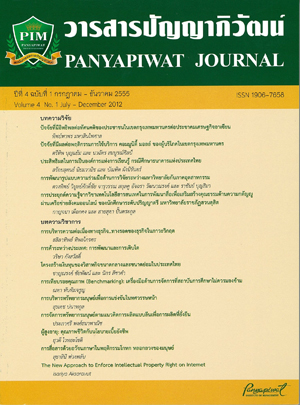โครงสร้างเงินทุนของวิสาหกิจขนาดกลางและขนาดย่อมในประเทศไทย
Main Article Content
บทคัดย่อ
โครงสร้างเงินทุนคือสัดส่วนของหนี้สินระยะยาวต่อทุน ธุรกิจจำเป็นต้องมีโครงสร้างเงินทุนที่เหมาะสม ซึ่งสะท้อนถึงความแข็งแกร่งของธุรกิจนั้น เพราะธุรกิจจะต้องเลือกระหว่างความเสี่ยงและผลตอบแทน ในปี พ.ศ. 2553 พบว่ามีวิสาหกิจขนาดกลางและขนาดย่อมจำนวน 2,913,167 ราย คิดเป็นร้อยละ 99.60 ในแง่การจ้างงานพบว่ามีการจ้างงานมากถึง 10,507,507 คน คิดเป็นร้อยละ 77.86 ดังนั้น การส่งเสริมวิสาหกิจขนาดกลางและขนาดย่อมจึงเป็นเรื่องสำคัญสำหรับประเทศไทย เพราะก่อให้เกิดการจ้างงานเป็นจำนวนมาก และสร้างความเจริญกระจายไปทุกๆ จังหวัด ไม่กระจุกตัวอยู่เฉพาะในเมืองหลวง อย่างไรก็ตาม ถึงแม้ว่ารัฐบาลจะมีโครงการส่งเสริมและสนับสนุนวิสาหกิจขนาดกลางและขนาดย่อม รวมถึงการจัดอบรบให้ความรู้แก่ผู้ประกอบการอยู่เป็นประจำ แต่วิสาหกิจขนาดกลางและขนาดย่อมหลายๆ รายยังประสบปัญหาทางการเงิน สาเหตุประการหนึ่งมาจากผู้ประกอบการขาดความรู้เรื่องการจัดการโครงสร้างเงินทุนที่เหมาะสม นอกจากนี้ ในการจัดสรรงบประมาณสนับสนุนธุรกิจขนาดย่อมภาครัฐควรจะต้องพิจารณาเรื่องโครงสร้างเงินทุนประกอบด้วย
Capital structure means proportion of a long-term debt per capital. It is necessary for business to have suitable capital structure to reflect its strength. Normally, business has to choose between risk and profit. In 2010, there were 2,913,167 small and medium enterprises or 99.60 per cent with 10,507,507 employees or 77.86 per cent. So, promoting small and medium enterprises is considered an important issue for Thailand as it causes a large amount of employment as well as helps spread the growth to all provinces, not only in Bangkok. In spite of the fact that the government has launched many projects to support small and medium enterprises and conduct trainings frequently to provide knowledge to entrepreneurs, many small and medium enterprises still encounter financial problems. One of the causes is because most entrepreneurs lack knowledge to manage capital structure appropriately. In addition, when allocating the budget for supporting SMEs, the government should take the issue of capital structure into consideration.
Article Details
“ข้าพเจ้าและผู้เขียนร่วม (ถ้ามี) ขอรับรองว่า บทความที่เสนอมานี้ยังไม่เคยได้รับการตีพิมพ์และไม่ได้อยู่ระหว่างกระบวนการพิจารณาลงตีพิมพ์ในวารสารหรือแหล่งเผยแพร่อื่นใด ข้าพเจ้าและผู้เขียนร่วมยอมรับหลักเกณฑ์การพิจารณาต้นฉบับ ทั้งยินยอมให้กองบรรณาธิการมีสิทธิ์พิจารณาและตรวจแก้ต้นฉบับได้ตามที่เห็นสมควร พร้อมนี้ขอมอบลิขสิทธิ์บทความที่ได้รับการตีพิมพ์ให้แก่สถาบันการจัดการปัญญาภิวัฒน์หากมีการฟ้องร้องเรื่องการละเมิดลิขสิทธิ์เกี่ยวกับภาพ กราฟ ข้อความส่วนใดส่วนหนึ่งและ/หรือข้อคิดเห็นที่ปรากฏในบทความข้าพเจ้าและผู้เขียนร่วมยินยอมรับผิดชอบแต่เพียงฝ่ายเดียว”
เอกสารอ้างอิง
จิรพันธ์ สกุณา และวีระพงศ์ มาลัย. (2553). วิสาหกิจขนาดกลางและขนาดย่อมกับการส่งเสริมจาก หน่วยงานภาครัฐ. วารสารนักบริหาร, 30(4), 219-223.
พรรณภา ธุวนิมิตรกุล. (2548). การเงินธุรกิจ. กรุงเทพฯ:สํานักพิมพ์มหาวิทยาลัยธรรมศาสตร์.
ศิรินุช ปัญคิวจณาณ์ และนิตนา สุริศักดิ์. (2553) การวิเคราะห์ปัจจัยทางการตลาดที่มีผลต่อความ สําเร็จของผู้ประกอบการในอุตสาหกรรมฟอกหนัง ในประเทศไทย, BU ACADEMIC REVIEW, 9(ฉบับพิเศษ 1), 167-176.
สถาบันพัฒนาความรู้ตลาดทุน ตลาดหลักทรัพย์แห่งประเทศไทย. (2548). การเงินธุรกิจ. กรุงเทพฯ อมรินทร์.
สถาบันพัฒนาวิสาหกิจขนาดกลางและขนาดย่อม(2551). นิยาม SMEsสืบค้นเมื่อ 8 กรกฎาคม 2555, จาก http://www.ismed.or.th/SME2/src/bin/ controller.php?view=generalContents...Id=273
สมนึก เอื้อจิระพงษ์พันธ์ ปิยะ ปานผู้มีทรัพย์ และจันทิมา ว่องเจริญวัฒนา. (2552). ปัจจัยกําหนด โครงสร้างเงินทุนของบริษัทที่จดทะเบียนในตลาด หลักทรัพย์แห่งประเทศไทยช่วงก่อนและภายหลัง เกิดวิกฤติเศรษฐกิจ. วารสารสงขลานครินทร์ ฉบับสังคมศาสตร์และมนุษยศาสตร์, 15(5), 25-38.
สํานักงานส่งเสริมวิสาหกิจขนาดกลางและขนาดย่อม(2554), รายงานสถานการณ์วิสาหกิจขนาดกลาง และขนาดย่อมประจําปี 2553 และแนวโน้ม ปี 2554 สืบค้นเมื่อ 12 กรกฎาคม 2555, จาก http:// www.sme.go.th/SiteCollection Documents/
White%20Paper/2552-new/chapter-4.pdf.
อัจฉรา ลาภจตุรพิธ. (2552). การศึกษาปัจจัยสภาวะทางเศรษฐกิจและคุณลักษณะของบริษัทที่มีผลต่อ การปรับโครงสร้างเงินทุน. วิทยานิพนธ์บริหารธุรกิจมหาบัณฑิต, มหาวิทยาลัยรามคําแหง.
Brigham, E.F. & Houston, J.F. (2001). Fundamentals of Financial Management. 9th ed.Mason, OH: South-Western.
Chang, C., Lee, A.C. & Lee, C.F. (2009). Determinants of capital structure choice: A structural equation modeling approach. The Quarterly Review of Economics and Finance, 49(2), 197-213.
Chen, J.J. (2004). Determinants of capital structures of Chinese-listed companies.Journal of Business Research, 57, 1341-1351.
Hall, G.C., Hutchinson, P.J. & Michaelas, N.(2004). Determinants of capital structures of European SMEs. Journal of Business Finance & Accounting, 31(5-6), 711-728.
Huang, S.G.H. & Song. F.M. (2006). The determinants of capital structure: Evidence from China. China Economic Review, 17(1), 14-36.
Joreskog, K.G. & Goldberger, A.S. (1975). Estimation of a model with multiple indicators and multiple causes of a single latent variable. Journal of the American Statistical Association, 70(351), 631-639.
Korajczyk, Robert A. & Levy, Amnon. (2003).Capital structure choice: Macroeconomic conditions and financial constraints. Journal of Financial Economics, 68(1), 75-109.
Modigliani, F. & Miller, M.H. (1958). The cost of capital, corporation finance and the theory of investment. The American Economic Review, 48(3), 261-297.
Nguyen, T.D.K. & Ramachandran, N. (2006).Capital structure in small and medium-sized enterprises: The case of Vietnam. ASEAN Economic Bulletin, 23(2), 192-211.
Titman, S. & Wessels, R. (1988). The determinants of capital structure choice. Journal of Finance, 40(1), 1-19.
Yang, C.-C., Lee, C.-F., Gu, Y.-X., & Lee, Y.-W.(2010). Co-determination of capital structure and stock returns - A LISREL approach an empirical test of Taiwan stock markets. The Quarterly Review of Economics and Finance, 50(2), 222-233.


